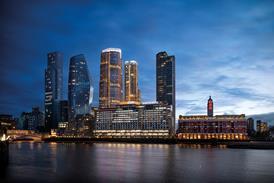This time, however, it was staged in the recently refurbished Florence Hall, which now looks like the sort of supremely stylish room you might expect to find in, say, the headquarters of an institute of architects that knew what it was doing. Even the four-screen projector worked ã not, unfortunately, a foregone conclusion at previous RIBA events. Not only that, the extremely high-spirited party was organised by the RIBA's in-house catering department. Not that outgoing president Marco Goldschmied was actually out in Dublin Bay, black Armani trousers rolled up and brandishing a shrimping net; but if you are going to hire a catering company to run the RIBA's extremely popular restaurant, you may as well get it to cater for all the functions.
The RIBA's building at 66 Portland Place is one of the best advertisements the profession has. As long as it is going to advocate that design excellence is the principal objective of those commissioning building work and that architects are the only professionals able to deliver this, it makes sense that the institute puts its own house in order first. Members have been talking about improving the building for years but only very recently has something actually been done. As anyone in the construction industry knows, getting two architects to agree on an appropriate doorknob is hard enough. So instead of expecting 75 architects to decide on the entire headquarters refurbishment, the institute sensibly took its own advice and commissioned an individual firm of architects (Allies and Morrison) to do it for them.
No doubt there will be dissent over the ôÈ100,000 spent on a piece of design the size of a mosaic tile
To show that it realises the world is moving on, the RIBA has also rebranded itself. I don't know how its new look will affect the construction industry as a whole ã contractors tend to notice the figures on the bottom line of an architect's certificate rather than the shape of the logo adorning it. Whereas the old Lions of Mycenae looked as though they'd climbed off a plinth at Trafalgar Square, the revamped ones have the six-pack solar plexus of the lean and fit and look like something that would feel more at home in a computer game. No doubt there will be plenty of dissent over the ôÈ100,000 expenditure on a piece of design work the size of a mosaic tile, but this is no more than a contemporary example of "the colour of the factory walls" syndrome.
In the early 1950s, when everybody thought psychology was going to be the answer to everything, a firm that made sewing machines decided to see if the colour of its factory walls had an effect on the workforce. First they changed the pale grey to red; production went up. Two months later, they spent a weekend painting it blue; production went up again. Encouraged by this they changed it to green ã production went up yet again. With some trepidation, they returned it to the original pale grey, but production continued to improve. It turned out that the operators didn't actually care what colour the walls were. The fact that their employers were taking an interest made them feel better and so they worked more efficiently.
Postscript
Gus Alexander runs his own architectural practice in Clerkenwell, London.























